#shakespearian illustrations
Text

Edwin Austin Abbey (American, 1852-1911) • The Queen in Hamlet • 1895 • Pastel on paperboard • Illustration for the play Hamlet, by William Shakespeare
Edwin Austin Abbey was an American painter and illustrator who identified with the British Pre-Raphaelites. He was an Anglophile, whose subjects were almost always British. Edwin Abbey's Shakespearean works influenced late Victorian stage productions.
#illustration#art#illustrator#artwork#edwin austin abbey#american artist#shakespearian illustrations#anglophile#william shakespeare#plays#stage sets#pastels#drawing#sassafras and moonshine blog#illustration blog#pre raphaelites
35 notes
·
View notes
Text
Fantasy sights: William Heath Robinson
William Heath Robinson was an English cartoonist and illustrator of the early 20th century.
He did various Shakespearian illustrations - he most notably illustrated Twelfth Night, in such a way to convey its dark, eerie, ghostly and oniric tones beyond the comedy aspects...
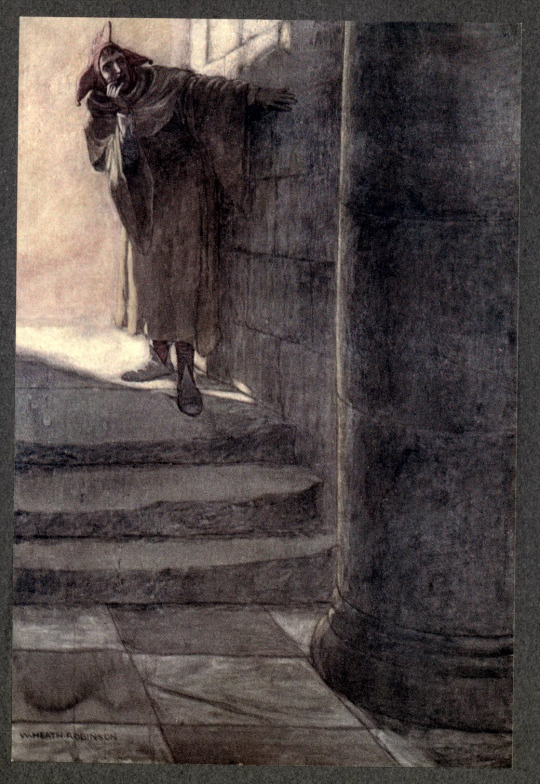

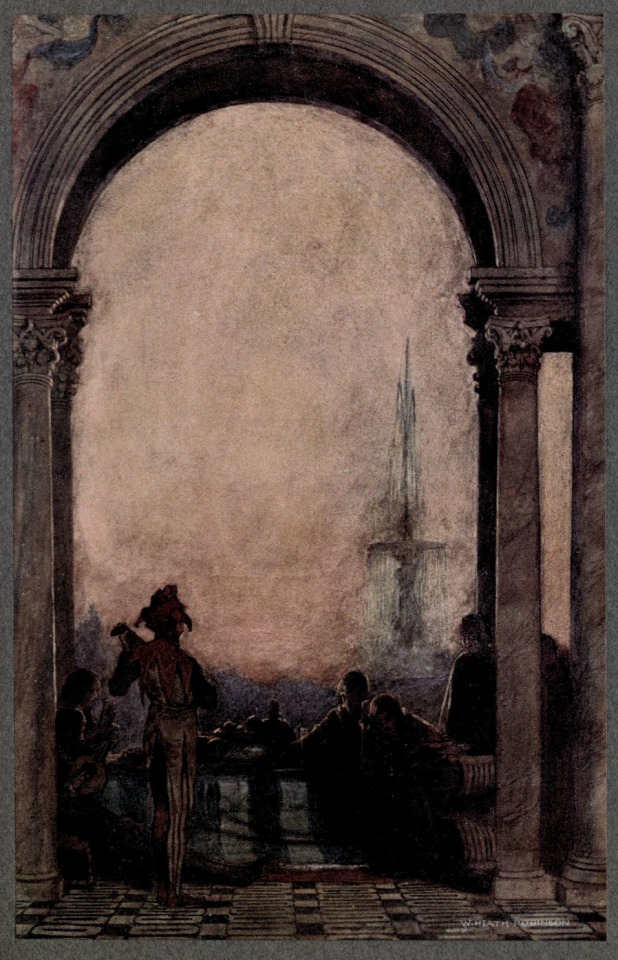
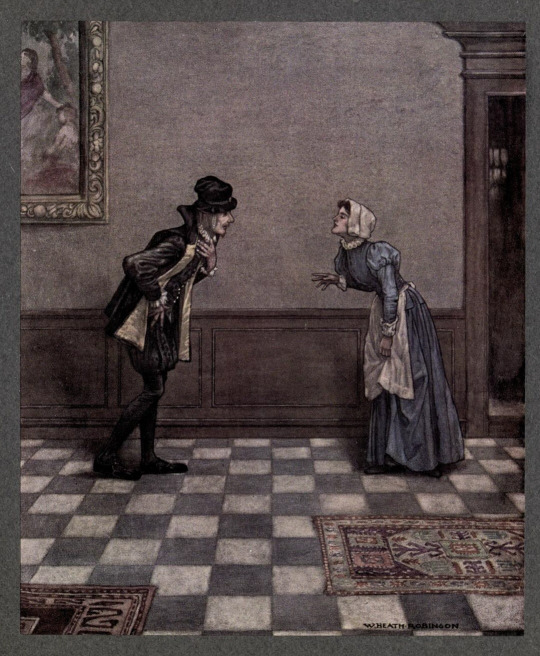

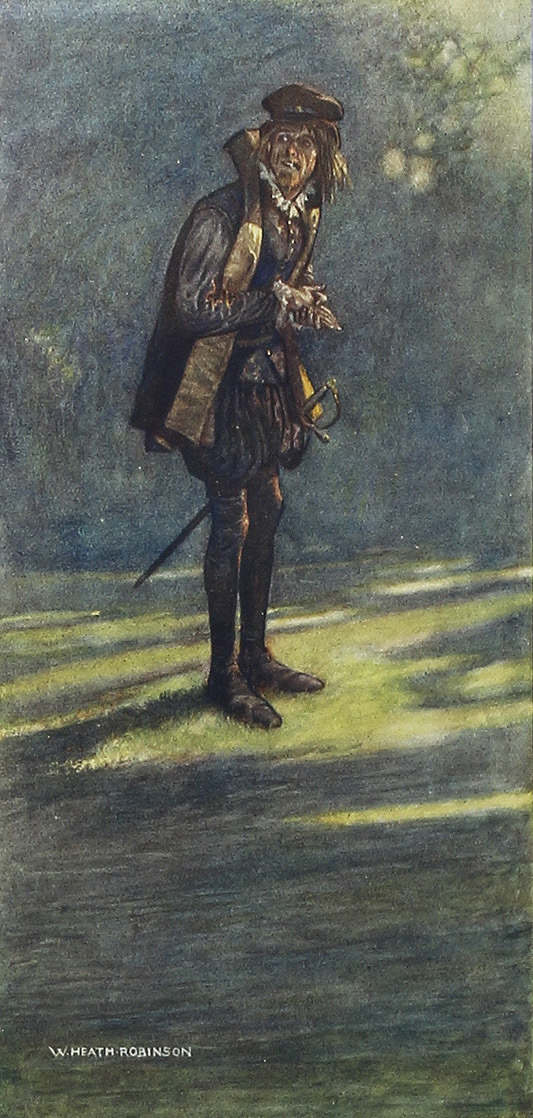
And he also did some very famous illustrations for A Midsummer Night's Dream


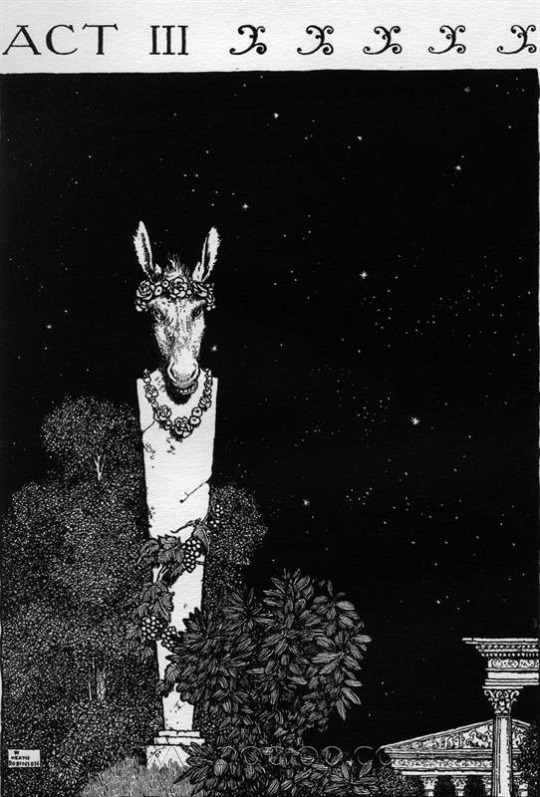

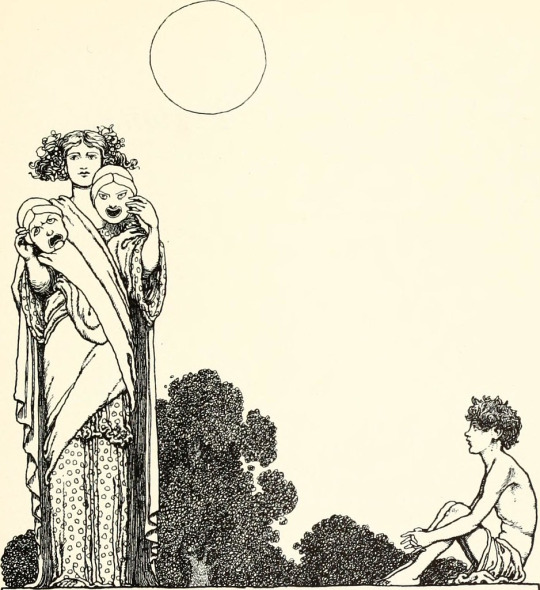
Robinson also did an illustrated version of "The Pantagruel and the Gargantua", sometimes grouped together as William Heath Robinson's The Rabelais.


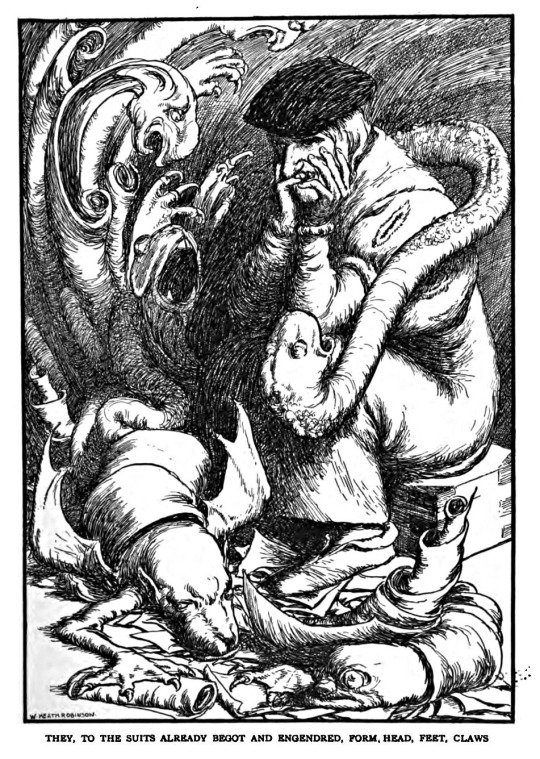
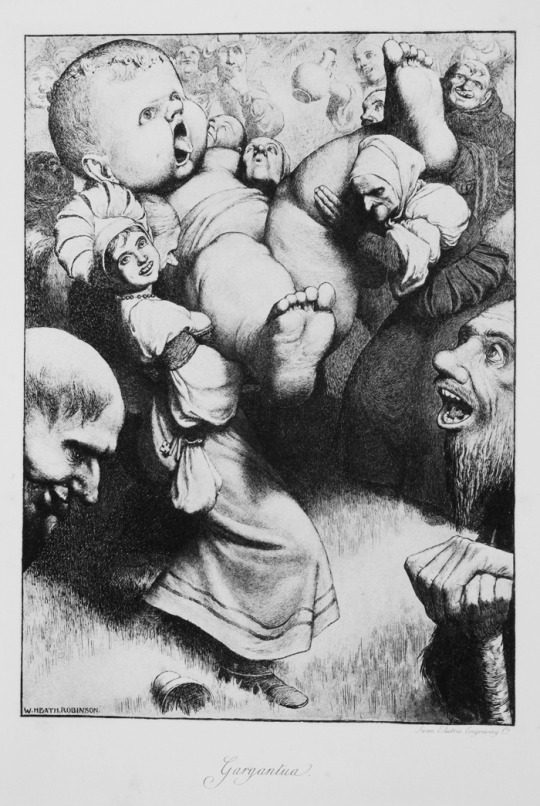



William Heath Robinson was also very as a fairytale illustrator - but since there's a lot more, I'll place them under a cut.
He illustrated Andersen's fairy tales...
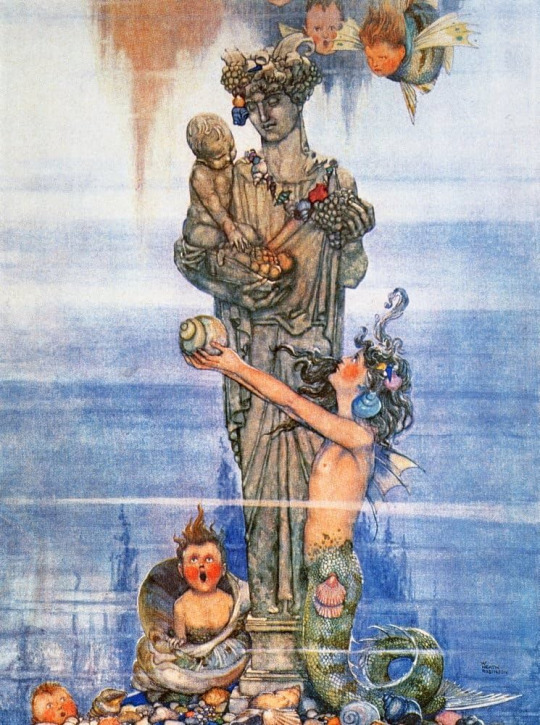
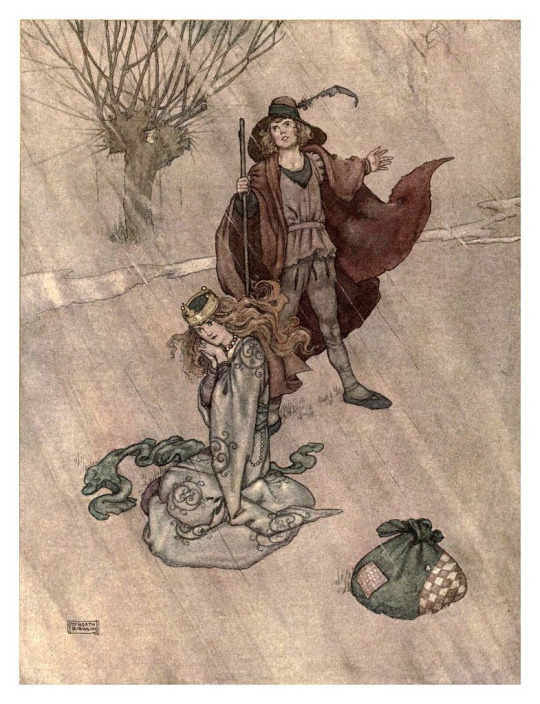
He created an illustrated version of "The Arabian Nights"...


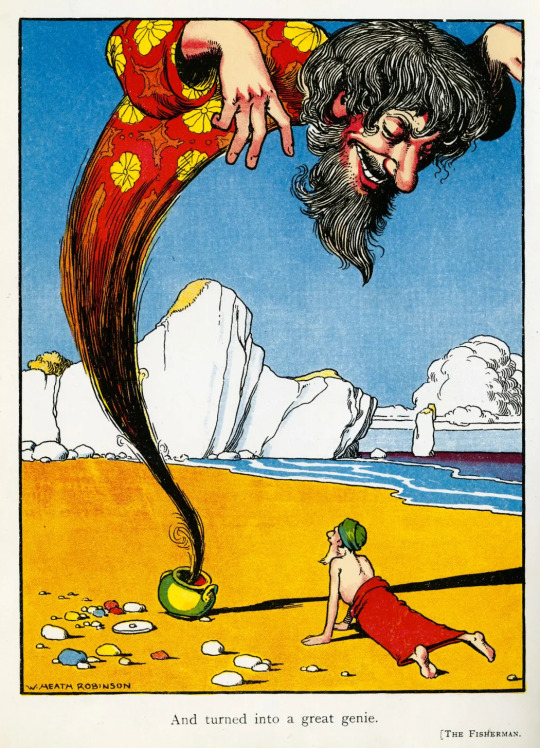
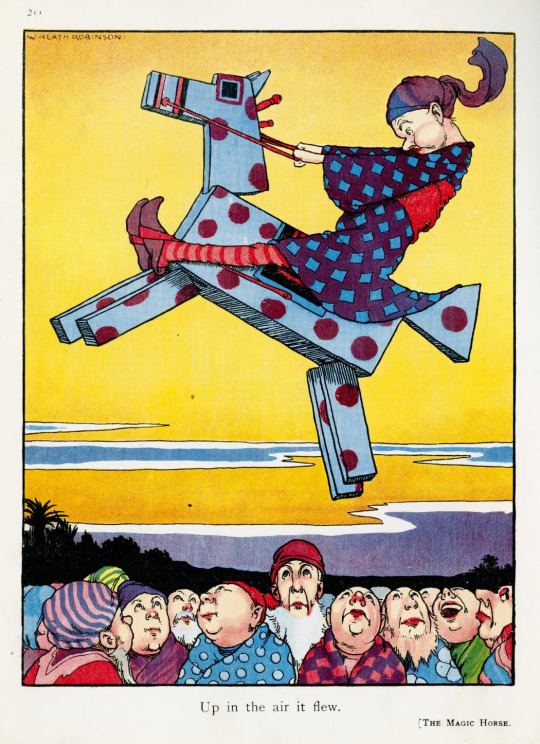

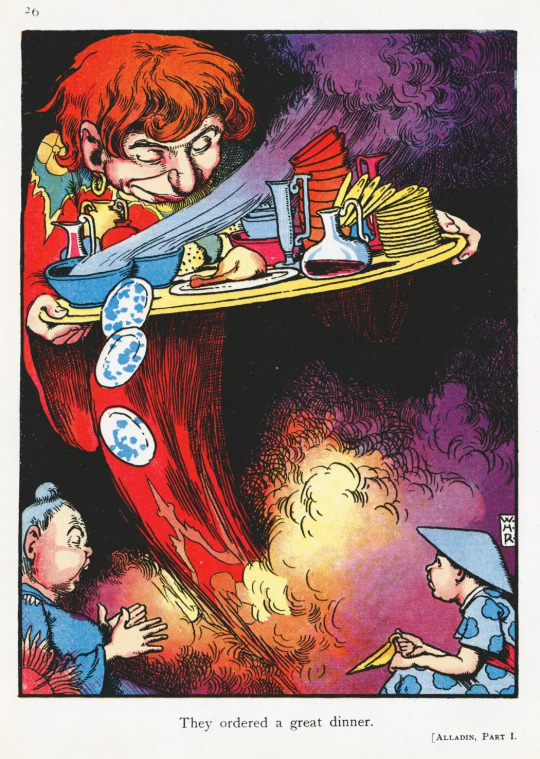
And he also illustrated various children-oriented productions, such as Walter de la Mare's "Peacock Pie" or Charles Kingsley's "The Water-Babies".




#william heath robinson#fantasy sights#fairytale illustrations#fairytale art#shakespearian illustrations#shakespeare art#a midsummer night's dream#twelfth night#the arabian nights#rabelais#gargantua#pantagruel
112 notes
·
View notes
Text
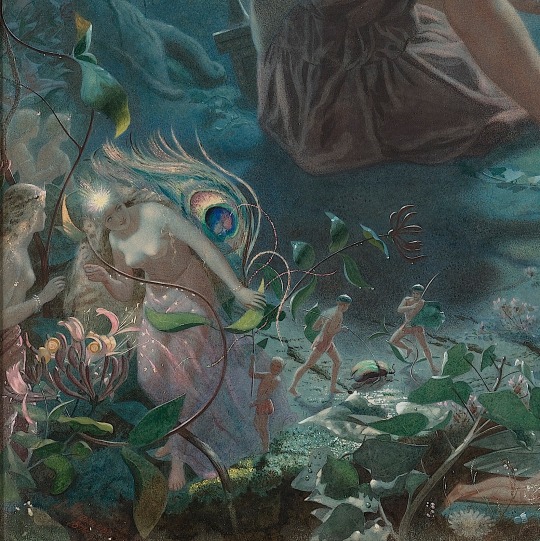


Hermia & Lysander (detail) ~ from "A Midsummer Night's Dream" ~ 1873 ~ John Simmons (a British miniature painter and illustrator, known primarily for his watercolours of ethereal fairyland scenes, often illustrating Shakespearian or other literary works, 1823–1876)
176 notes
·
View notes
Note
For the Shakespearian quote thing. "Does thou mother know, you weareth her drapes?" ....I'm sorry, but I had too!
((No worries, Anon! It’s a popular one, and therefore already been done.
Here’s the original post with an illustration from the book.
Here’s the cool gifset made by the awesome @aintinacage
If you think of more, send them to @aintinacage or me! Thanks!))

3 notes
·
View notes
Text
I truly think that one of the most intriguing parts about succession is how it tows the line between high and low culture. the show works when portraying a legacy media company because every single bit of it feels like something grand and old shifting into something fast paced and new.
This can be seen in the music, with the gravitas orchestral sounds fused together with hip-hop and rap, creating an almost clunky sound which perfectly illustrates waystar's desperation to keep up with other media outlets. Specifically, L to the OG and Roman's Beat both being from/about characters that have grown up as part of the company, whilst also wanting to develop it into something new, is a very deliberate choice.
it can also be seen in the dialogue used thought-out. I've always thought that the use of words in the show has felt poetic and somewhat shakespearian, with intertextual references and swear words grounding the dialogue in the modern world. this also highlights the class of the people who speak in that way, as it suggests that they have grown up high class, in comparison to the few working class characters who refrain from speaking in that way.
finally, the entire narrative can also foster the idea of high and low culture colliding. Jesse Armstrong was initially inspired by the lives of the Murdoch family, a family that owns things such as fox news in the US, as well as many other media producers throughout England and Australia. However, the story also plays out like a Greek tragedy, with the characters destined to fail. these two factors merged together creates a narrative as old as time, set in a world that is contemporary and ever evolving.
anthropologist Claude Levi-Strauss once suggested that binary opposites (such as good Vs evil) in media drive forward the narrative. in this case, I believe that what drives forward successions narrative is the conflict of old Vs new, represented through the use of high and low culture in its technical and visual codes.
#hbo succession#succession#apologies for that last bit but i have a media a level coming up and i need to revise so I'm using this as a means to :0#roman roy#kendall roy#media studies
17 notes
·
View notes
Text
Animation Night 110: Berserk
That manga... No... too large to be called a manga...
Hello once more my friends! Happy Thursday. It’s finally time for Berserk!

So. Today we’re going to be looking at one of the adaptations of Berserk - not the renowned 90s TV show, although I will tuck in an episode of that, but the movie trilogy by Studio 4°C that ran from 2012 to 2013. But first! Let’s talk about the manga...
What has not been said about Kentaro Miura’s genre-defining epic? Probably very little, but that’s never stopped me before!
So. Berserk is a ‘dark fantasy’ manga series that ran from 1989, when Kentaro Miura was just 23, until his death in May last year - a span of 32 years. At this point I have read up to
The story has gone, as you’d expect, many different places, but broadly it is a projection of the horrors of the European Wars of Religion into a heightened fantasy world - all centered on the character of Guts, a badass traveling swordsman who, marked for demonic sacrifice, persists in the world out of sheer stubbornness and battles the demonic ‘Apostles’.

The real meat of it begins with the Golden Age arc, the point where we see just how great a storyteller Miura really is. He precisely lays out a kind of grand Shakespearian tragedy, following Guts’s growth to adulthood with a mercenary band led by the iconic ambitious (evil) femboy Griffith, and the grand betrayal that set him on the present path. Even though we have some idea how it will end, the story rolls on with a feeling of terrible inevitability.
One of the great strengths of Berserk is the sheer variety of emotional tones Miura can convey. It is of course best known for its incredibly vivid and detailed battle scenes, the splattery panels of people being hacked apart by swords - and certainly Miura is one of the best at composing action, and a ludicrously methodical illustrator. Berserk loves to deliver the spectacle of, say, a massive cavalry charge...

(Look at all these horses in distinct, active poses and dynamic perspective, the use of value in the composition to make sure it reads, the sheer amount of effort put into precise hatching around the muscle shapes of each horse. I can only imagine how long it took to draw just this one panel.)
But more than that, Miura is capable of portraying moments of painful tenderness and wicked humour. The Golden Age arc wouldn’t work nearly so well if we didn’t feel the sense of camaraderie in the Band of the Hawk, watch Guts warm up to them, or even ourselves come to believe in Griffith’s dream. The horror of the eventual climax at the Eclipse depends on all of these moments leading up to it.
Yet that’s only the first quarter 100 chapters or so of a manga that has so far reached around 364 (with Miura’s assistant Kōji Mori now set to continue). Following this point, the story enters the Conviction arc, beginning with relatively self-contained stories but building up into a new story about a depraved inquisitor. Miura has a good eye for turning these stories into not just a monster of the week, but compelling self-contained story in its own right (usually a very sad one!), embedded in an overall arc of the traumatised Guts cracking his cynical shell and slowly growing to once again accept connections to other people and become more of a protector figure.
So by the following Falcon of the Millenium Empire arc, the central cast has expanded considerably: Guts, now on a mission to heal his wife Casca who has been traumatised to the point of taking on a totally childlike demeanour, gradually finds himself joined by a whole party. Puck the elf (here more like a fairy than a LotR elf) is a fourth-wall-breaking Greek chorus present from the start; alongside him arrive Isidro, a young boy who idolises guts and tends to form the comic relief; Farnesse, once an aristocratic witch-hunter fascinated by flames; Serpico, her loyal retainer and secret brother; eventually even Schierke the young apprentice witch and her own elf companion Ivalera.

One of the biggest concerns of Berserk is to show how these various characters came to be as they are, and show the events unfolding as a chain of causality. Every so often, we’ll dive into a flashback to flesh out one of the central characters, and honestly these tend to be some of my favourite parts of the story.
This idea of causality is actually explicitly discussed by characters like the mysterious Skull Knight, implied to be something of a predecessor to Guts who seems to have a sense of how the plot will unfold; Guts is described as existing outside the chain of causality by virtue of being sacrificed - and though he has become a kind of homo sacer to be killed with impunity by demons, this also gives him the opportunity to intervene in events. But how is in question; Guts is torn between two impulses: his desire for revenge on Griffith, his desire to protect Casca and the others who came under his wing, mixed his fear about hurting people in rage and bloodlust during fighting.
All this must sound very macho, and yeah, it often is - but right from the very start of Berserk it’s balanced by symbols of effeminacy as well, whether in the form of Puck the neotenous elf (who the camera loves to linger on) or, of course, Griffith - and the relationship between Griffith and Guts is very heavy on sexual tension...
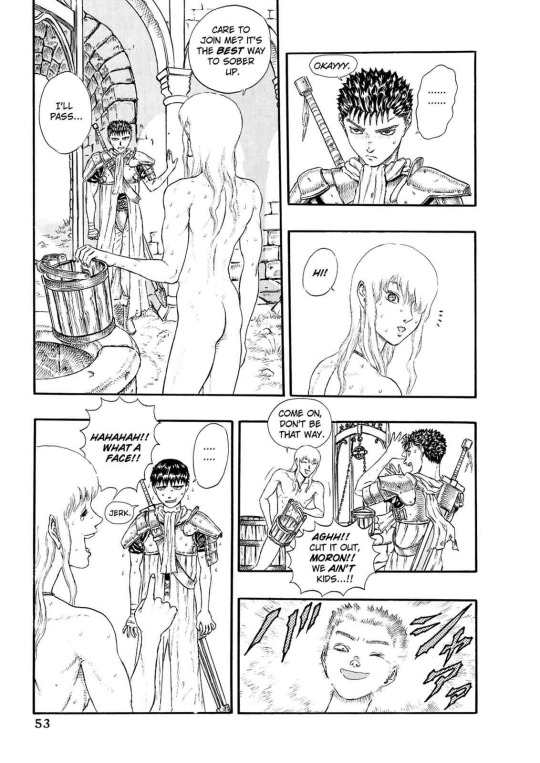
So, wherever did all this come from?
Prior to Berserk, I don’t believe this particular kind of fantasy manga was well-established. Certainly pretty much all subsequent works in the ‘dark fantasy’ genre, from other manga like Claymore (2001-2014) to games like Drag-on Dragoon (2003) and Dark Souls (2011) cite it as a massive influence.
In the 80s, Western fantasy works were enjoying a wave of popularity, particularly in computer RPGs attempting to capture the experience of D&D - which of course ended up with quite a different lineage in Japan (a divergence exemplified by the Wizardry series, which spawned a completely different line of sequels in Japan and the West). And by this point, Dragon Quest (1986) and Final Fantasy (1987) were on the scene; there was a big interest in fantasy art. However, the tone of these games was quite different, targeted much more at children.

Here we’ve got to tread a little carefully to avoid muddying the picture! When we talk about the ‘grimdark’ movement of Western fantasy novels that kicked off with A Song of Ice and Fire in 1996, there’s a narrative that claims all prior fantasy was highly moralistic and full of uncomplicated romantic heroes, but thanks to authors like Martin, there was a turn to cynical realpolitik, bloody violence and torture, and sex (and in particular lots of rape). But it’s not true; this narrative erases the whole ‘sword and sorcery’ and ‘dying earth’ subgenres from existence; in fact there has been ‘dark fantasy’ pretty much from the start, at the very least from the 1960s. Such works, particularly the writing of Jack Vance, Poul Anderson, Michael Moorcock, and (sigh) yes Lovecraft and Howard formed a major part of the fabric of D&D in 1974.
And indeed, Miura cites two major sword-and-sorcery works as part of his inspiration for Berserk’s setting: the 1982 film adaptation of Howard’s Conan the Barbarian (featuring Arnie!) and Moorcock’s Elric of Melnibone series. I think the Elric connection would be very interesting to develop, because Moorcock was definitely interested in the same sort of grand themes as Miura, but I’ll have to actually read it first lmao...
Alongside this, Miura cited some other works from the West, namely the films Mad Max (you can kinda see it) and Star Wars (bwuh?).

Of course, Miura also had plenty of influence within manga. Buronson and Tetsuo Hara’s post-apocalyptic fighting manga Fist of the North Star (北斗の拳, 1983-88) frequently comes up as a big influence, and we can certainly see the resemblance between Kenshiro (above) and Guts, as well as the general post-gekiga art style full of heavy hatching and intricate, thin lines that Miura would pick up so well.
Alongside that, Miura’s demons unsurprisingly owe a lot to Go Nagai; he also heavily praises Osamu Tezuka’s historical manga Dororo. But there’s actually another line of influence that may or may not be surprising: shōjo manga, particularly that of the Year 24 Group...
Miura commented about the influence of shōjo manga on the series, stating that it is about "expressing every feeling powerfully."[17][23] Particularly, he mentioned influence from Yumiko Ōshima,[17][23] and that the anime adaptations of The Rose of Versailles and Aim for the Ace!, both directed by Osamu Dezaki, inspired him to read The Rose of Versailles manga and the works of Keiko Takemiya, notably Kaze to Ki no Uta.[16][24]
Dezaki we covered previously on Animation Night 95, and we watched the anime adaptation of foundational yaoi manga Kaze to Ki no Uta back on Animation Night 69 - and, like, yeah! You can certainly see how Griffith in particular, with his flowing curly hair and pouty lips, looks like he comes straight from a shōjo manga - something perfectly fitting the larger-than-life charismatic hero role he assumes. And in general, this old school shōjo approach to storytelling proved an absolutely perfect fit for the quieter, emotional parts of the story: repeated lines to establish a certain cadence, panels which don’t show events but just establish mood, a certain wistful beauty.
It is the contrast between these two elements that makes Berserk sing. It invites you to indulge in its gleeful fascination with fever-dream ultraviolence but it’s also very determined in observing its consequences on the survivors.

Surely the most controversial aspect of Berserk is how frequently it portrays rape. Make no mistake, it is quite a lot, and if you do not want to deal with that, just don’t read Berserk.
So, how exactly does it go about this? Notably, the main three characters of Berserk are all survivors of sexual violence. Guts was betrayed by his father-figure early in life; Casca was rescued from rape by a noble by Griffith; a young Griffith did deeply traumatising sex work for a different noble to fund the Band of the Hawk in its early years. All three of these events, while they might be a bit absurd and melodramatic on some level, are treated with a great deal of care and gravitas - in particular, the arc of Guts and Casca sharing their respective stories and growing closer together and creating a more positive form of sexuality is one of the most affecting parts of the Golden Age arc, frankly the best het scene I’ve ever read lmao.
Furthering that approach is effective use of rape as an element of horror, namely the climax of the Golden Age arc, where (spoilers) the tortured Griffith, rescued from the king’s dungeon but too injured to ever carry on his rise as a mercenary leader, chooses to sacrifice the entire Band of the Hawk to demons in order to make himself a kind of demon lord. Most of them are torn to pieces, but Casca is raped, first by tentacle monsters and then by Griffith himself while Guts looks on powerlessly. The manga forces us, like Guts, to watch; it is one of the most viscerally upsetting scenes I’ve read in manga, even by contrast to the blood and guts and deaths of beloved characters throughout the rest of the eclipse.
At the same time, there’s a lot of rape or attempted rape that’s just kind of... there, part of the broader texture of violence that fills the series. Our actual and would-be rapists include mercenaries, apostles and at one point monstrous trolls; Casca in particular gets the absolute worst of it, with many attempted rapists showing up both before and after the eclipse. The first time I read Berserk, I felt strongly about such portrayals and couldn’t read much further than the Golden Age arc - now I’ve evidently changed my mind about what’s appropriate to treat in fiction in general.
At this point I think it’s up to each person to decide what they’re comfortable reading and all I can do is just, tell you what you’re in for.
Perhaps it’s worth digging into what role this serves. Berserk is of course deeply concerned with the subject of violence in general. Guts’s defining feature is his connection to violence; he has killed hundreds if not thousands of people and is separated from the rest of the world by the fact he’s attacked nightly by demons. It does a good job of depicting violence as both alluring and repulsive and in many ways, nihilistically treating it as just natural; we’re often reminded that the people slaughtered for Griffith’s dream or because they got on the wrong side of Guts are often just people, other mercenaries, who probably followed their own charismatic leader or just went to war because they had no other way to make a living. Moreover, it is very interested in notions of domination and powerlessness, and this is where the sexual violence fits in. And honestly, these kinds of ero-guro elements seem appropriate for what this story is about.
And yet, the way it treats rape is curiously... limited. It seems even a giant monster completely divorced from humanity will only ever get the tentacle dick out because they see a woman. Casca is often quite awkwardly depicted as ‘the girl one’, with most of her conflicts stemming from that - there’s even a plot point where she goes into battle and can’t fight as effectively because she’s on her period. Often it seems like the only way Miura can think to give a conflict to Casca is by having someone try to rape her. (By contrast, women who appear later in the story like Farnesse and Schierke tend to get very different conflicts - as much as even early Berserk features brilliant writing, I think Miura surely matured while writing it.)
One possible explanation I’ve heard is that Miura’s editors at Young Animal magazine knew that the sexual violence sells, so they would pressure him to put in things like rapist trolls to satisfy that side of the audience. Right now I don’t really have any evidence to confirm this one way or another.
So... all in all, it is what it is I guess. Know what you’re going in for and make your decision appropriately.

Berserk has been adapted to animation three times. The best known one is the TV adaptation by Oriental Light and Magic (OLM), best known for their adaptation of Pokémon(!), which actually began at the same time as their Berserk in 1997. It’s hard to imagine two more completely different franchises. Their adaptation, and in fact subsequent, focused on the Golden Age arc - unlike the manga which introduces the Golden Age as a flashback, it starts the story from the beginning.
This 90s anime series, although inevitably limited by the bounds of TV animation, was very well-loved and was for many people the first introduction of the series. Even with two cours (25 episodes) to play with, it had to cut a little, and due to TV censorship I’m told it ends rather abruptly in the middle of the eclipse sequence.
Notable is the soundtrack by Susumu Hirasawa, who would later become famous as the composer for almost all Satoshi Kon’s films (Animation Night 16, Animation Night 42). It’s got that classic 90s end-of-the-cel-era look, with muted colours and frequently impressively detailed drawings. It’s of the kind of vintage where encoders will be quite particular about preserving film grain or not!
However, two cours of anime is too much for Animation Night, so this is not the version of Berserk we’re going to cover. Instead, we’re going to look at Studio 4°C’s take, a trilogy of movies released 2012-2013.
Here, I may refer you to youtuber SteveM, who made a good retrospective on the trilogy in the context of 4°C’s broader work:
youtube
The impetus for this one comes from Lucent Pictures, who approached 4°C after seeing their work on films like Tekkonkinkreet and the Animatrix. Producer and 4°C cofounder Eiko Tanaka was actually unfamiliar with the work at the time; the decision to focus on the Golden Age arc comes from the screenwriter. First came a pilot in 2008, which earned Miura’s approval; the subsequent single movie ended up splitting into three to contain the material, and still cuts a lot compared to the pacing of the TV series.
4°C’s overall approach was to combine cel-shaded CG with traditional animation, an approach which would allow them to take on the enormous battle scenes and complex suits of armour. As SteveM describes, the result is... a bit of a mixed bag, visually speaking. 4°C are definitely one of the best when it comes to merging 2D and 3D, but this time they were applying it to living creatures rather than environments or machines for the first time. The results often looked awkward and uncanny in motion, with the attempt to animate the CG on 2s to mesh better with the 2D frequently ending up with the worst of both worlds. This was improved a lot by the time of the third movie, but still an unfortunate weakness.
Despite this, this is anything but a passionless project; they got in HEMA practitioners to choreograph the fights and went to considerable effort to include historical armour and weapons - perhaps a misguided effort since historical accuracy was never especially the point of Berserk, but definitely a sign of something. And at least going by the reactions of critics, the troubles were largely ironed out by the third movie, which finally got to deliver the Eclipse sequence in its full horrible splendour. In the comments of that video, there are some interesting discussions of what 4°C did better: some people point to the romantic scenes between Guts and Casca, the moment where Guts accidentally kills a child, and the amputation scene in the eclipse arc.
I don’t have an opinion yet! Right now I’m purely a manga reader and haven’t seen any adaptations of Berserk. So I’m looking forward to seeing how all this hangs together in full tonight. Berserk is something that’s impossible to adapt without some sort of compromise, so the strength of an adaptation will be what it chooses to make of the material.
And oh, god, look at the time - that’s about all I have time to write. Thanks for bearing with me. We’ll be starting the Berserk movie trilogy very shortly, at our usual spot, twitch.tv/canmom - hope you can join me, I’ve been looking forward to this a while!
21 notes
·
View notes
Text
Despite a generally difficult couple of months, this week one friend sent me a Shakespearian Insult Mug just because "It reminded me of you." Which is a tremendous compliment.
Then my Shrubby darling told a neighbor marveling over the illustrated edition of Grimms' fairytales I bought my smolest nibling that the book came from her son's "real fairy godmother," which is even HIGHER praise.
So, I figure if I'm leaving this kind of impression on people, even when things go wrong, I'm still doing okay.
9 notes
·
View notes
Note
Would you be able to give some references or places to read more about the humour stuff? I looooovvveee purgation motifs
YES. so first of all, just for getting an overview on humouralism, my go-to would probably be "passions and tempers: a history of the humours" by noga arikha. this covers a pretty broad historical sweep.
looking at purgation more specifically, "the expressiveness of the body and the divergence of greek and chinese medicine" by shigehisa kuriyama is sooo good. it's a comparative history, but the parts on chinese medicine are really mostly to illustrate points about greek med. also, the focus is on bloodletting specifically, but very similar logic about purgation and cleansing motivated a lot of other humoural medical treatments, and kuriyama does draw some of that out. this book is just so cool.
ok fuck it i'm just gonna bullet point the rest of this lmao
"a reconstruction of the hippocratic humoural theory of health" (balzer & eleftheriadis, 1991, journal for general philosophy of science. doi 10.1007/BF01801207) -- another good overview. more digestible length than a whole book
"humoring the body: emotions and the shakespearian stage" by gail kern paster -- really good look at how much we're missing when we disembody early modern drama, and given the influence of shakespeare over succ... yes
"the rise and decline of character: humoral psychology in ancient and early modern medical theory" (jacques bos, 2009, history of the human sciences. doi 10.1177/0952695109104422) -- historical argument is problematique but it gets the noggin rotating
"diseased bodies, defiled souls: corporality and religious difference in the reformation" (charles h parker, 2014, renaissance quarterly. doi 10.1086/679783) -- on catholic views of humoural 'defilement' vs calvinist views of sinful sensuality. reminder that the roys are catholic lol
"you are what you eat: historical changes in ideas about food and identity" (steven shapin, 2014, historical research. doi 10.1111/1468-2281.12059) -- intro to food and temperaments, including humoural aspects. side note, literally love steven shapin. please read him.
"'you have no good blood in your body': oral communication in sixteenth-century physicians' medical practice" (michael stolberg, 2014, medical history. doi 10.1017/mdh.2014.71) -- patients' views of the body as unclean and in need of purification/evacuation/etc
"blood matters: studies in european literature and thought, 1400–1700" ed. bonnie lander johnson & eleanor decamp -- as the title suggests, mostly focussed on blood. but includes analysis of blood as a humour, and also shows how this kind of analysis can help us make sense of literature/media
"humoural wombs on the shakespearian stage" by amy kenny -- more shakespeare, lots of Gender. looks at performance history in conjunction with humoural theory
most of these books you should be able to find free on z lib etc, and with the articles access varies but if you hit a paywall, lmk and i might be able to float you a pdf. also if you read german or french there's a lot of lit on humouralism out there.
oh and also you can snowball the reference lists in any of these things and be pretty sure you're finding good stuff!
14 notes
·
View notes
Text
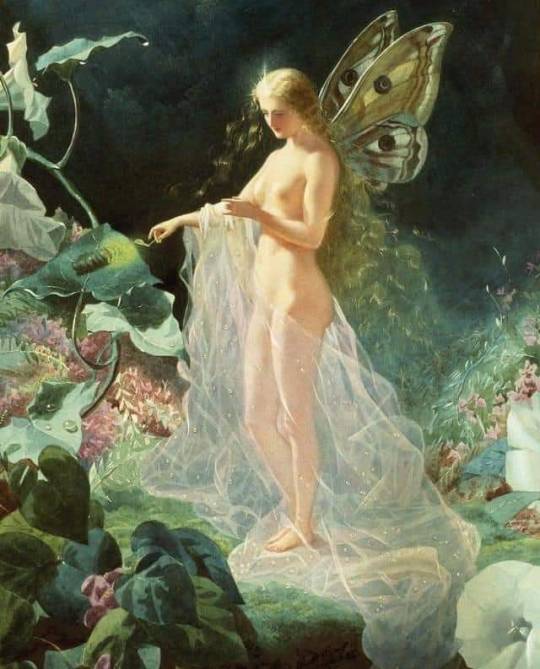
• John Simmons (British, 1823-1876)
‘Titania’ 1866
John Simmons (1823–1876) was a British miniature painter and illustrator, known primarily for his watercolors of ethereal fairyland scenes, often illustrating Shakespearian or other literary works (such as his illustrations for A Midsummer Night's Dream). He was one of several popular Victorian artists who together created "a genre of forest idyll" in their fairy paintings. They are often grouped with the Pre-Raphaelites.
2 notes
·
View notes
Photo

couple of drama queens
#artists on tumblr#cartoon art#digital art#wanted to illustrate me and lil's dramatic ass middle school selves in our shakespearian plot#we were SO EXTRA#cleanfur#furry art#yeah no shame at this point these are furries#art#illustration#cute#kawaii#concept art#theatre#expressions
46 notes
·
View notes
Text
Soul Reaver: The Tragic Masterpiece
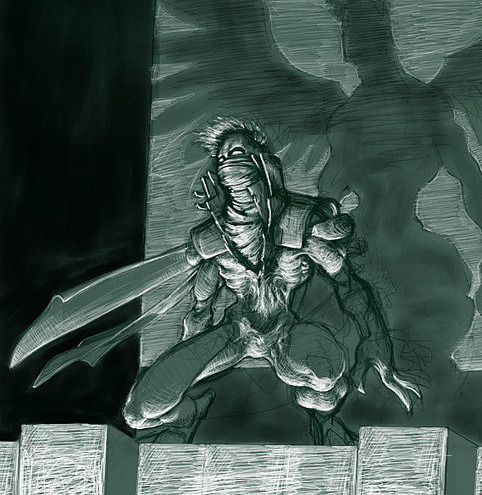
[Illustration: early Raziel concept art by Arnold Ayala]
[Article by Oasis Nadrama, 08/04/2022]
In 1999 came out a promising, inspiring video game, bound to become a legend on Sony's Playstation. It was the second title in the story-focused Legacy of Kain series, and according to a number of reviewers and passionate spirits, "may have been the most overly ambitious game ever".
So what makes it so special? Why, but why exactly is Legacy of Kain: Soul Reaver such a masterpiece?
DERELICT NOSGOTH: ORIGINALITY AND INSPIRATION
The first quality is the originality and sheer strength of the setting.
This is a post-apocalyptic steampunk arabic/ancient-civilizations-inspired post-medieval-fantasy organic horror gnostic multiple-planes-of-existence universe with a parallel spectral ecosystem.
Yeah, really. That's what we're going for here.
Soul Reaver takes an incredible quantity of ancient, classical, modern and contemporary influences, too many to list them all here; it takes Gnosticism, hindu myths; it takes the Paradise Lost poetry, Piranesi's etchings of imaginary prisons, Judaic, Christian, Islamic inspiration; it takes contemporary inspirations such as German Expressionism, Vampire the Masquerade, Necroscope, Atlantis fishmen and Xenomorphs and it weaves them all into its own unique mythology, also incorporating it into its very gameplay with the multiple clans and territories.
Raziel and the Spectral Realm alone are already aesthetical victories, both heavily influenced by the weirdest ideas (Raziel's vampire physionomy comes from Cesare in The Cabinet of Dr. Caligari, and his wraith form borrows from Vishnu, classical vampires and zombies as well as adding a variety of unique details such as the reversed Razielim symbol prolonging the black tears, or the two spines) but becoming fantastical visions and cultural icons in their own right.
OVERALL UNICITY
Inspiration is nothing without making something more, something consistent and unique, something also going further, adding to the eternal conversation of human culture and creation. And Soul Reaver's unicity is the Legacy of Kain series at is strongest, all inspirations are entirely digested and used to reinforce the main experience whose various aspects are so strongly intertwined they become indistinguishable from each other.
Gameplay, story and universe all answer to each other directly all the time.
Why can the player character come back after each failure? In Soul Reaver it receives a direct and intradiegetic explanation in addition to the usual extradiegetic one: because Raziel CANNOT die, that's the very point of the game, to not have any game over.
Why don't we have an inventory this time? You are naked, you are a soul, you have nothing and in fact you will abandon the Physical Realm all the time to shift into the Spectral Realm, your new natural environment.
Why is the entire world filled with monsters? Because it is a dying world invaded by vampires.
Why can't we talk to people? Because we're an undead demon creature, enemy to every vampire, which inspires fear (or devotion, depending on your playthrough) to the few remaining human beings.
Why is every fight a kind of puzzle? Because vampires cannot be killed by a simple accumulation of wounds.
Etc etc.
All parts of the gameplay are defined by the story and universe. All part of the story are defined by the gameplay and universe. All parts of the universe are defined by the gameplay and story. They are all braided into a single, strong rope, Raziel's quest for revenge.
AHEAD OF ITS TIME, A CONTINOUS AND DUAL-STRUCTURE WORLD
Soul Reaver was a very ambitious project. Besides the worldbuilding work, the desire to bring deep care to its writing and a Shakespearian aspect to its voice acting, it was also a brave work in a number of areas.
It aimed to offer an incredibly large world to begin with. Sadly it did not entirely succeed : in the end, 1/3 of the game's explorable areas were cut, as well as a number of abilities. In fact, the Soul Reaver we know is a vastly cut and rewritten work, explaining the unsatisfying ending and the overall feeling of "something lacking". But that is another story for another time (one can look at Divine Shadow's thread on the Soul Reaver cut content, for example, for more information). This article focuses only on the game as it effectively came out in 1999, with its own flaws and merits.
Even with the large cuts, the game world of Soul Reaver is still a large environment... and one without interruption.
Yeah, it's an uninterrupted world. It is easy to overlook today, but one has to realize: much like Dark Souls 1 and other more recent games, you can walk through the entirety of Soul Reaver, from beginning to end, without any loading screen. The "streaming" loading technology kept the CD running and the environment loading through a number of tricks. In the end, the team had to tweak a lot of thing (lowered texture quality, more twisted corridors etc) to make it work, but it worked. And it was unheard of on the first Playstation console, and almost unheard of in computer games as well. This was, by itself, a REVOLUTION.
Soul Reaver doubles down on this feat by making this uninterrupted game world literally DOUBLE: each environment is effectively doubled, mirrored in the Spectral Realm, each and every wall and ground is distorted and gains an entirely different palette (and often different or distorted textures). Stairways become columns, columns become stairways, pillars change heights or bend beyond recognition, chasms open or close, protrusions emerge or blend from the environments. Angles become brutal and lighting nightmarish, Raziel suddenly dives into a full expressionnist otherworld. This is of course the solution to a variety of riddles, as well as a instinct for shifting the player progressively acquires, but it is a technical and aesthetical victory.
INNOVATING FURTHER, THE DYNAMIC SOUNDTRACK
A huge part of the Soul Reaver experience is the soundtrack.
(And really, even if you're not a music lover, DO NOT SKIP THIS PART OF THE ARTICLE. This is just incredible stuff.)
Sadly, that is an aspect that the players of the PC port did not experience, for they were cursed with a rushed port, amputated from the entire feature (replaced with one-track-per-level) and often inheriting the wrong themes. This is also an aspect players of the ruined "W" version, recently removed from Steam (easy to recognize, it's a version with weird achievements ruining the immersion, as well as an added fanmap of Nosgoth falsely indicated as an "ingame map"), were not able to discover.
The composer of Soul Reaver, Kurt Harland, was passionately involved in the development of the universe (going as far as participating in the writing for Soul Reaver 2) and went overboard with the -new by then, and still powerful by 2020s standards- idea of a DYNAMIC SOUNDTRACK.
In the original Playstation 1 version as well as the Dreamcast upgraded version, the OST is flexible and adapts itself deeply to the player's progression. Depending on the rythm and fights Raziel is facing at a given time, the soundtrack will also change pace, and add other instruments! Similarly, one won't experience the same soundtrack in the Material and Spectral Realms.
Each area of the game effectively has TEN tracks: indoor, outdoor, puzzle, danger and combat, both done in physical and spectral variations (five tracks for each world), and the game shifts between them in real time according to the situation the player is dealing with.
This is also not counting the boss themes, all being both reinterpretations of the main theme (the legendary Ozar Midrashim music) and thematically tied to the area and Lieutenant Raziel is facing.
The Soul Reaver soundtrack, and the way it interacts with the game, is a masterpiece in its own right.
OFTEN-OVERLOOKED DETAILS
While the adventure may be lacking details in its landscape (more on this in the next part), it is often forgotten how subtly rich the gameplay rich. You can do fifty walkthroughs of Soul Reaver and still miss important secrets (in fact, that’s exactly what your fellow player Oasis did, I didn’t find the “Reaver altar” hiding a mystical upgrade in the early Melchahim territory until two years ago!). You can finish the game without finding out you can pick up rocks, quietly drop weapons on the ground (you have to crouch then to use the weapon button), rekindle torches or befriend humans by sparing the life of the very first vampire hunter you meet.
Here’s a little trivia: the big stone face by the Force Glyph altar is a representation of Nupraptor (also highlighted by the brain motif on the ground).
And a nice trick: by picking up heavy items while swimming, you can actually walk underwater. And this allows you to do something else underwater as well... But why should one tell? The game doesn’t. It is, by design, a story of few words, and its hidden subtleties are one of its most valuable gifts.
LEGACY, GENEROSITY AND STREAMLINING
At first glance Soul Reaver may pale when compared to Blood Omen, particularly in graphics and gameplay possibilities. There's so much less spells, secrets, colorful details... Even the scale of the map is reduced. It does generally follow the Blood Omen geography when you superimpose the maps (with a few tweaks) but large roads turn into narrow pathways, huge landscapes become desert courtyards. Nupraptor's Retreat no longer dominates a huge valley blooming with medieval urban life but stands broken atop a rocky gorge... The general state of desolation of the land does not help, making everything bleak, grayish and lacking in details.
One shall not argue that everything is okay in this area. The reduced scale and palette are real aesthetic flaws of the game. It does participate in leaving a feeling of emptiness. It IS lacking in details and the general colors could have done with some more audacity (maybe closer to the alpha versions of the game which featured a more colorful Spectral Realm, interesting contrast to a Physical Realm devoid of life).
But other aspects are much more deliberate choices and not necessarily inferior.
There ARE less spells and secrets, but each glyph has its use (against various kinds of enemies, in various situations) and all glyph chapels are interesting moments of reflection.
The Fire Reaver (only remain of a sadly cut aspect of the game, the Reaver Forges) is an especially great discovery, allowing the explorer to make quick work of most vampires in the late parts of the game.
Secret areas are no longer simple secret doors and off-screen teleporters beyond some lake, but secondary parts of the environment you can find by observation and experimentation, or even by natural progression, and they are HUGE areas: the Human City, Nupraptor's Retreat, the Fire Glyph chapel, the Lighthouse... These gigantic environments are entirely missable and yet received as much attention as the ones you obligatorily go through; in fact, this optional content represents almost HALF of the game's entire explorable world. Yes, half of the game's world is basically optional. This level of dedication and generosity was already rare in late 1990s level design, and almost alien to 2020s video games.
When it comes to general gameplay, Soul Reaver's main proposal was to provide a streamlined version of the Blood Omen approach. If you think about it, you do not lose much interaction, in fact an entire dimension of gameplay is added (it IS a 3D game, and making much use of this new depth of space, with a lot of verticality in the level design, funny aspects with the climbing, jumping, swimming and air currents, as well as adding aspects of targeting and manipulation of various objects). And while Fledgling Kain may have had more possibilities in his arsenal (one cannot argue with that, particularly with the various armors and weapons, as well as the mind-control spells and the Font of Putrescence), the main idea of the boss-gained powers allowing more exploration of the environment is much better done in Soul Reaver, and effectively makes you go organically, fluidly from a corridor-based game to an entire world you explore with ease.
It also develops an identity of its own with the puzzle game aspect. Block puzzles can be seen as a concrete (sic) flaw of the game - they may be too numerous and not diverse enough to the taste of contemporary players - but they are linked to the overall approach of a large quest for meaning, solutions, answers.
The combat system can be understood with the same perspective: it is an extension of the general puzzle game aspect of the overall experience. The fights present the player with situations to solve, and the boss fights are the final and strongest incarnation of this approach.
A STORY OF FEW WORDS, A SHARPENED EXPERIENCE
Soul Reaver has less lore and dialogues than its predecessor. That cannot be denied. But is it such a shame?
There are two big rules in academic writing, "Less is more" and "Show, don't tell". While they do not universally apply (and would deprive us of some incredibly weird and intense narrative experiences such as Herbert's Dune or Palmer's Terra Ignota), they can be considered here.
Half of Blood Omen's dialogue could easily be discarded without affecting much our understanding of Kain and the situation. The same cannot be said of Soul Reaver. Almost every line of dialogue and monologue is important, each of them brings us to new aspects of the world, characters and actions, and much is suggested between the lines. With a few words, the exchanges with the Lieutenants hint at complex social interactions and power balances, the Elder God already appears as a duplicitous character with its own agenda, and Kain's fatalism and master plan are strongly drawn.
The game tells much through its very action, its atmosphere, its music and architecture. It tells us the story of a dying world, of an existential impasse for the entire universe, of the final consequences of Kain's fateful decision. It tells us of the suffering, determination and misguided self-righteousness of Raziel. It tells us we need to solve something, the final riddle, the enigma of our sad wraith's own fate.
Today, one can easily gloss over the qualities of the game. Yes, it’s an old game, with rough 3D and often simple textures, a particular approach to in-game death, spaced dialogues and a lot of block puzzles.
But it is also one of the strongest and most original stories of its time, an experimental, powerful and detailed gameplay proposal, an incredibly generous game environment, a masterful mise-en-scène, an exceptional soundtrack and an amazing moment of voice acting. the virtues of this work of art are numerous, and reunited into a sharpened, focused, cruel poetic experience, reaping the spirits of countless players to this day: Soul Reaver, the tale of Raziel's walk towards his grand and tragic destiny.
52 notes
·
View notes
Text
Fantasy sights: Ingres
In my "fantasy read-list" I mostly focus on fantasy texts, but I also include things such as operas or movies. But there is a type of fantasy-inspiring or fantasy-made content I can't talk about in my list: paintings, illustrations, drawings, the original visual mediums. So this is where the "fantasy sights" series comes in, a complement-series presenting some paintings, illustrations and artists either born out of fantasy, or that inspired fantasy.
Let's start with some classics - classical paintings taking back subjects from the "primordial" fantasy of Greek myths, Shakespearian plays, Ossianic epics and more...
To start it all: Ingres. Jean-Auguste Dominique Ingres, one of the great French painters of the 19th century.
We begin with one of his most famous works, taken from Greek mythology, "Oedipus explaining the enigma to the Sphinx".

Following this, we have the painting "Roger saving Angélique". From the Orlando Furioso. I do not recall talking about this poem in my reading-list, and yet I should have - but this will be a "little surprise" for those that take the time to both look at the reading-list and watch-list.
The Orlando Furioso is an epic poem of the 16th century composed by the famous Italian poet, the Ariosto. This epic is very noticeable for being a mix of actual historical epic (the background is the war between Charlemagne and the Saracens), of medieval knight-and-warrior adventures (Merlin and Roland appear, among others), and of Greco-Roman motifs (the episode of the "Orco" is a retelling of the Cyclop's tale in the Odyssey, the enchantress Alcina is a perverse and evil Circe, and in the episode depicted here, the Saracen knight Roger saves the princess Angélique from a sea-monster the same way Perseus saved Andromeda from a sea-beast).

We move on to the Ossian-mania that swept Europe when his poems were "found" (wink wink) and translated (wink wink wink), and Ingres' very famous painting meant to illustrate this Celtic epic poetry: Le songe d'Ossian, The dream of Ossian.

We return to Greek mythology with this time another very famous piece of Ingres: Jupiter and Thetis. This is actually an illustration of Homer's The Iliad, depicting the very first chant, and how Thetis the sea-goddess left her watery dwelling to go to Olympos high up in the sky, in order to beg Zeus to spare the life of her son, the hero Achilles.

To match "The dream of Ossian" celebrating this Celtic poetry, I had to place Ingres' piece, "Homer deified, or the apotheosis of Homer", showing the ancient aedes Homer being crowned in front of all the great artists and storytellers of history (including actual modern writers and famous French figures - you can see Boileau, Molière, La Fontaine, Racine, Dante, Phidias, Pindar and many more...)
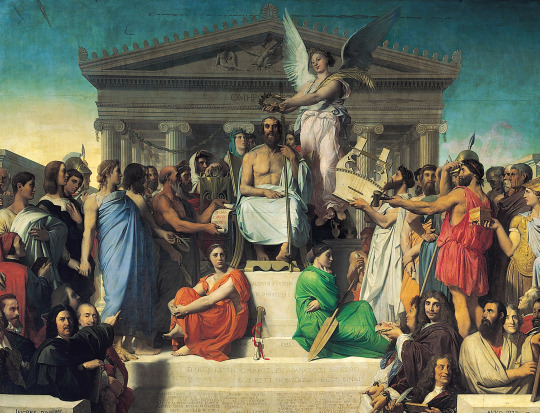
#paintings#greek mythology#zeus#thetis#oedipus#sphinx#ingres#homer#ossian#orlando furioso#jean-auguste dominique ingres#french painting#19th century painting#the art of the myth#fantasy sights
5 notes
·
View notes
Text
If you like beautifully written children/all age’s fiction you might like...
My descriptions are going to be a little useless so I linked their Overdrive profiles that have actually good descriptions.
Howl’s Moving Castle (Diana Wayne Jones)
3 book series but both sequels are completely optional. All three books tie up super neatly. I wouldn’t read them out of order though. I never got around to finishing the 3rd book but when I tell you that the first one is my favorite book in existence. I’m pretty sure I’ve read it through about a dozen times. The reread value is astronomical. I would write the author a letter if she was still alive.

don’t expect the same story. but yes
Guardians of Childhood (William Joyce)
Honestly I haven’t yet finished this series either but there are 5 novels. If you’ve seen the movie you can kind of think of the books as a prequel story but really it’s the movie that’s the sequel. Another series in which if you don’t make it through all the books it’s pretty much fine. If you can get your hands on a hard copy I highly recommend it because it’s beautifully illustrated. There are also picture book versions of each book that are absolutely gorgeous.

These guys, yeah

Same author

Oh, and this one too
Tangled in Time (Kathryn Lasky)
Ok, so have I finished any of these series? no. In this case though it’s because it’s a very new book and when I read it the sequel wasn’t out yet. This one does do actual cliff hangers though so rip me. I’ll get to the sequel eventually. the premise? think kinda gay, fashionable middle schooler starts randomly time traveling into different points of the life of Queen Elizabeth I. She meets key players like Henry VIII, at least one of his wives, and Elizabeth’s siblings.
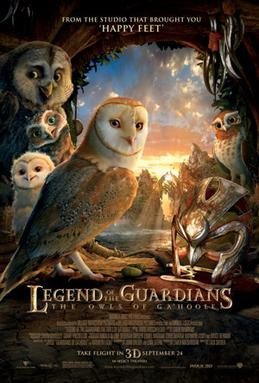
If you remember this movie, same author.
First Light (Rebecca Stead)
The only title here not part of a series. First Light is one of my favorite books. I’ve read it in full 3 times. Rebecca Stead’s stories tend to be very real world based, very logical, very grounded but with a twist of sci-fi or fantasy. I would definitely consider it an all ages book but this one does lean a little more into being for children. But that might just be that global warming was pretty new to the public conscience when it was written so it might just be a spot of poor aging. We switch between the perspectives of a young boy and a young girl as they navigate the mysteries of their families and wait to see where their stories intersect.
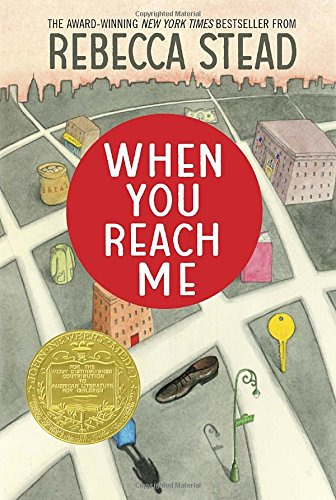
if you recognize this book, I believe it was written after First Light
Sisters of the Sword (Maya Snow)
So this series does not get enough credit. It’s absolutely amazing. And no, I never finished it. But think Shakespearian levels of family drama + Mulan gender stuff + Japanese samurai + preteens obviously. I originally read it when I was in about 4th grade (so think age 8 thereabouts) so don’t mistake how tough kids truly are but I will say this one is pretty violent. I don’t want to say much though because I don’t want to spoil the great beginning. But like, yeah, there is actual sword violence and blood.
#book rec#book recs#book recommendations#howls moving castle#guardians of childhood#tangled in time#first light#sisters of the sword
13 notes
·
View notes
Text
Best shows I watched in 2020
I wanted to look at some shows I watched that I felt had some of the best writing. Most of these shows did not come out in 2020 but are shows that definitely deserve some attention for their masterful writing. Minor spoilers below.
1.Succession

This show took me by complete surprise. While I love stories about complicated, and darker characters I went into this show expecting it to be a classic story about power dynamics among the rich. And it is but the show is really about cycles of abuse and trauma and how that relates to a capitalist system. The show follows the children of billionaire Logan Roy as they continuously jostle for power within the family company, it’s very Shakespearian in nature but also one of the most absurd and hilarious shows on.
The writing on this show is very interesting because none of the characters can actually say what they want to say, it is all disguised such as a politician’s word choices would be. And bringing that veiled rhetoric into a family dynamic makes for an exploration of power and manipulation. The writing is also significant for doing something called by the cast, “the language of strength” which is using aggressive and sexually charged language frequently, this is used both in the company and within the family as both intimidation and to show off. There’s really a lot to dissect in word choice and meaning in this show and for that reason it is fascinating.
2. Hannibal

This was another show I didn’t expect to like but was pleasantly surprised by. This show ended its series in 2015 but it has always been a cult favorite and has been receiving renewed attention as of late and all I can say is thank god. This is a brilliant show both visually and story-wise. As I watched the first season I felt like I was stepping into a different world of just complete madness, and the show is really escapism in that way even though it features horrific deaths every episode. While I don’t think this is the best written show out of all the ones listed here, and I do think it expresses itself more through visual prose rather than words it is still reminiscent of a dark epic poem.
The show follows FBI consultant Will Graham as he investigates a series of grisly murders and comes across the path of notable psychiatrist Hannibal Lecter (also notable cannibal and serial killer). The writing is very interesting due to it’s plentiful of metaphors. In regards to the main relationship between Will and Hannibal the distinctions between wanting to “eat” one’s love and wanting to be with them are really interesting and the word choices made can only be called poetic.
3. Atlanta

I went on a Donald Glover kick after finishing Community and I’m so happy I did because it led me to this show. Many have called this show “what TV could be” and it really is. This show starts off simply enough with the story of Earn trying to become a music agent for his cousin, the rapper Paper Boi. But the show delves deeply into the surreal in order to illustrate its points about poverty and being black in America.
The writing on this show bucks traditional story structure completely with each episode being more of a “day-in-the life” rather than a continuous plot driven towards a goal, this allows for much more experimentation but also the feeling that no matter what the characters do they’re going to get weighed down in some way or other. This disregard for classic show structure also bleeds into the genre, it’s hard to solely classify this show as a comedy because there are so many elements of horror, drama, and satire within it. The writing is overall beautiful, heartbreaking, and hilarious. This show is a must watch as it is probably the best thing on TV right now.
4. Ramy
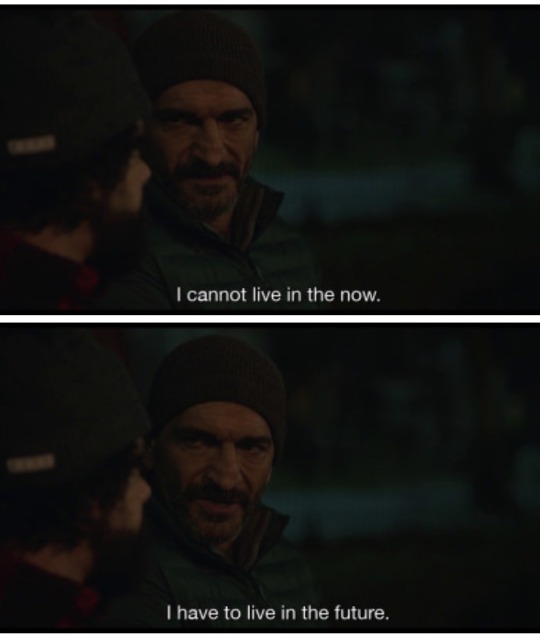
This show is the spiritual successor to shows like Atlanta and Fleabag who have paved the way for this new brand of comedy show, often focused around a single character as they try to better their lives. Ramy is a show about a Muslim- American milennial who is trying to get more in touch with his religion, thinking that it will help him to get his life on track. While the humor can be brass and the story lines can get pretty weird and disgusting the first word I think of with this show is delicate.
Especially in its second season, which has moved away from Ramy’s perspective to focus on the rest of his family. The writing in this show can swing from a really fragile sense of beauty to super crass and sexual in the blink of the eye, which makes it so hilarious and interesting to watch. The writers have complied a series of character studies under the guise of a TV show, and watching this family deal with issues of assimilation, lost dreams, religion, and loneliness makes the watcher feel deeply connected to them.There’s a lot of stuff happening in this show that is very fragile but very moving and also hilarious.
5. The Great

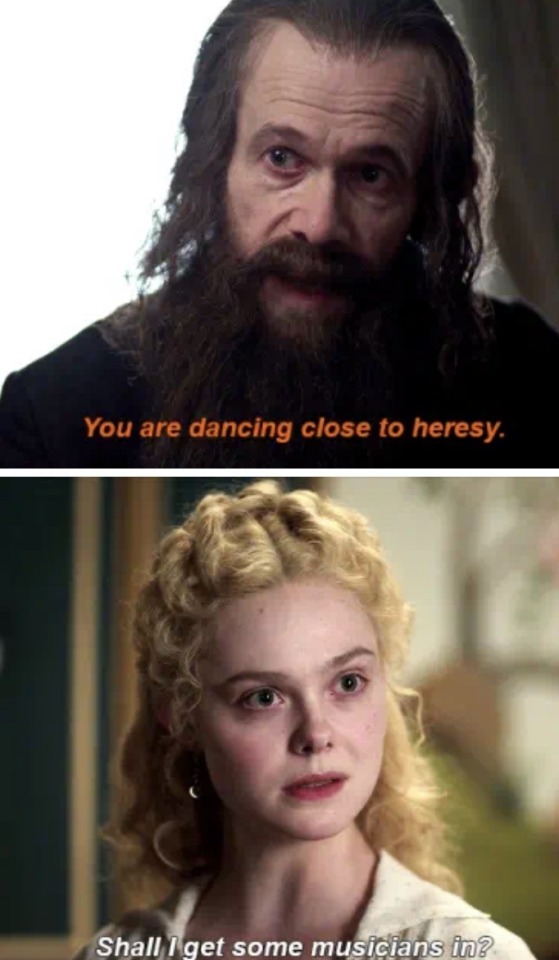
This show is chaos embodied. From excessive violence, sex, and rampant and ridiculous abuse of power this comedy which is extremely loosely based on Catherine the great’s life is a real ride. It was created by the writer of The Favourite and interacts with absurdity and power in similar ways.
The writing is really interesting because it is so crass. In that way it is meant to be humorous but also terrifying. Many things in this show act in more than one way- Peter (Russia’s emperor) is terrifying, ridiculous, and lovable sometimes all within a single scene. And this ability to be all of these things makes this a very good examination of power.
6. Veep

This is how you do a villain arc. Perhaps the best and most honest show about American politics Veep focuses on Selina Meyer, the first female Vice President who is surrounded by the most competent incompetent people and virtually powerless and unfulfilled in her job. Throughout the seven seasons we follow her through presidential campaigns and personal woes all in classic dark comedy style. While this show is first and foremost a comedy it is not afraid, as it’s ending shows, to dig into dark themes and character exploration of a narcissist with a bottomless thirst for power going after the highest office in the country.
This show predates the Trumpian era America currently finds itself in but much of it’s subject matter and even specific plot points have come to be echoed in our current history. Such as an election depending on the results out of Nevada and a politician’s base protesting to “Count the vote” and “Stop the count”. This just proves that the show is so in-touch with the reality of American politics (even when the show was just a satire rather than the bleak truth). This is a perfect dark comedy with excellent, well-crafted characters, and solid plot points. Definitely a must watch for anyone.
#best shows 2020#hannibal#veep#the great#succession#ramy#atlanta#ramy fx#atlanta fx#writing#screenwriting#tv shows#best tv shows#power
124 notes
·
View notes
Text
Vivy: Fluorite Eye’s Song – 09 – Diva’s Final Curtain

Matsumoto, always entertaining when thrown for a loop, finds himself speaking to Antonio through Ophelia, as he decides the best way to fulfill his mission to support her was to become her, sparing her the burden of fame and the pursuit of perfection, but also sparing her an independent existence. He considers his mission far more noble than Matsumoto’s designs to prevent her suicide, though he might not say that if he knew the bigger picture.
Speaking of that, Kakitani’s youth is promptly explained: he’s an AI copy of the human, and his mission is to get an answer he couldn’t from his teacher, which only Vivy could provide. That means infecting the captured Diva with a custom logic palette that “doesn’t belong in this era” which, throughout the episode, slowly erases Diva’s personality, eventually leaving only Vivy behind to answer him.
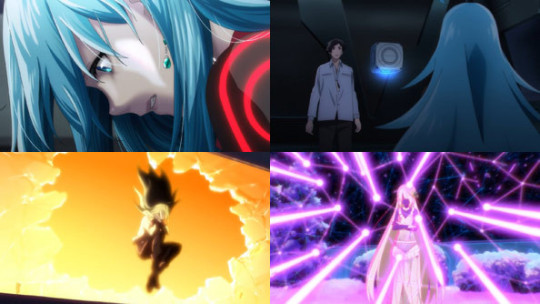
Thankfully, it’s a slow countdown, and while it is technically a ticking clock, because it’s only one of several spinning plates in this arc finale, it feels earned rather than cliched. That it is an inevitability even Matsumoto’s hacking skillz cannot override also adds gravitas to every moment Diva is on screen, because they’ll be her last.
It also assures that the titular Vivy we know and love, who can neither act like a human nor sing half as well as Diva, will ultimately return. It occurs to me that at the conclusion of every previous arc, we didn’t just say goodbye to one of Vivy’s sisters, but a part of Vivy as well, as her interactions with them helped her grow, both as a songstress and a person.
This time we don’t just say goodbye to a part of Vivy, but an entire alternate version of her, who lived for sixty years. It’s a tough loss…but before she goes Diva makes sure she puts absolutely everything she’s got in all the time she has left to be the best temporary partner to Matsumoto he could ask for…and vice versa.
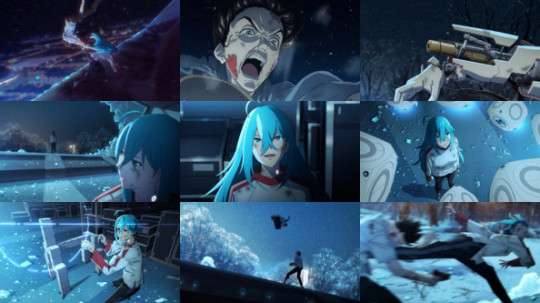
While packed with drama, pathos, tragedy and romance, Wit Studio flexes its muscles like never before in this episode, as we cut between the parallel battles, one of the more abstract electronic variety, one more down-and-dirty hand-to-hand combat, but both equally gorgeous an awesome to watch unfold.
That Kakitani is also an AI means both he and Diva can take the fight to levels humans would not be able to survive, while Matsumoto manages to copy himself into enough cubes to fight his battle with Antonio while supporting Diva. Compare this to Antonio, who happily accepted Kakitani’s help but is otherwise not working towards the same mission, making them inherently weaker against a united front.

Among other Kakitani’s surprises is an elaborate arm cannon (always a sharp feature when going on a timeline-bending crusade to avenge his mentor—and a special knife that seems to act as an EMP, deactivating the Matsumoto cubes aiding Diva.
All the while, Diva tries to impress upon Kakitani the fact that she’s not Vivy, and has no answers for him he’ll find satisfying. When she says she puts everything she has into her singing to make people happy, that includes everything about Vivy, despite her knowing next to nothing about her.
On the Antonio side of things, Matsumoto says he almost turned into him, discarding his partner as part of his “perfect calculations”. Looking at what’s become of Antonio, he’s not glad he didn’t eliminate her. As for his mission, it was never specifically to stop Ophelia’s suicide; it was to carry out the Singularity Project with his partner.

Even taking over Ophelia couldn’t satisfy Antonio, because no matter how happy the crowds were with his performances, he always knew he wouldn’t be able to match the power of the true Ophelia’s singing. In fact, it irked him that their standards for excellence were so low, resenting the very people it was Ophelia’s mission to make happy.
The Matsumoto cubes manage to hack both Antonio and Kakitani and disable both, and transfers Antonio back into his own clunky body. It’s only then in his last moments that he admits that all he really wanted was for Ophelia to sing for him and no one else. Ophelia, regaining consciousness before shutting down, admits she only wanted to sing for him; to make him smile.
In the end, their mutual love and devotion to each other corrupted their missions. In true Shakespearian tragic fashion, it was a love that could never be. In that same vein, the moment Kakitani uploaded that logic palette, Diva was a version of Vivy that could never be, even though she did a bang-up job serving as Matsumoto’s partner. Before Kakitani shuts down, he tries to twist the knife once more, telling Diva “there were humans who suffered because you existed!”

That line might’ve worked on Vivy, but it doesn’t faze Diva that much. And in true Diva fashion, she gives one last snap and tells Matsumoto she’s going to use her last five or so minutes of existence doing what she was built to do: dazzle the stage, put her heart into her singing, and make everyone in attendance happy to be there. As she performs, she simultaneously opens a dialogue with Vivy within the Construct.
In this lovely parallel scene, their positions couldn’t be better illustrated, as Diva is both on stage and in the brightly lit classroom, while Vivy is relegated to a dark, shadowy, morose office. The pair lean against the same door, and Diva says she hears how Vivy had been struggling with putting her heart into her singing. She says the answer is to simply to hear the song she’s singing now, in her final performance, as in the Construct she slowly dissolves away into cybernetic oblivion.
And yet, as Vivy opens the door and steps into the light, then wakes up on stage to a deliriously ecstatic crowd cheering the song Diva just sang, Vivy still doesn’t understand. Then again, she only just woke back up; maybe she needs a few decades to process what she heard and what it means. Thanks to Diva, she has her existence back, which means anything is possible for her. As long as she sticks with her partner Matsumoto, who promised Diva he’d take care of her.

By: braverade
1 note
·
View note
Text
And of all these things the Albino whale was the symbol. Wonder ye then at the fiery hunt? | Moby-Dick reread, riff 12
And of all these things the Albino whale was the symbol. Wonder ye then at the fiery hunt? | Moby-Dick reread, riff 12
Moby-Dick illustration by Barry Moser
I. In this riff: Ch. 37-48.
II. Oof. Twelve chapters. Not sure how up to covering them I am, but let’s go—
III. Ch. 37, “Sunset.”
Ahab has just revealed that The Pequod’s true mission is vengeance on Moby Dick. “Sunset” is a short chapter and continues the Shakespearian mode initiated in Ch. 36, “The Quarter-Deck.” (It begins with the stage direction, “By the…

View On WordPress
3 notes
·
View notes